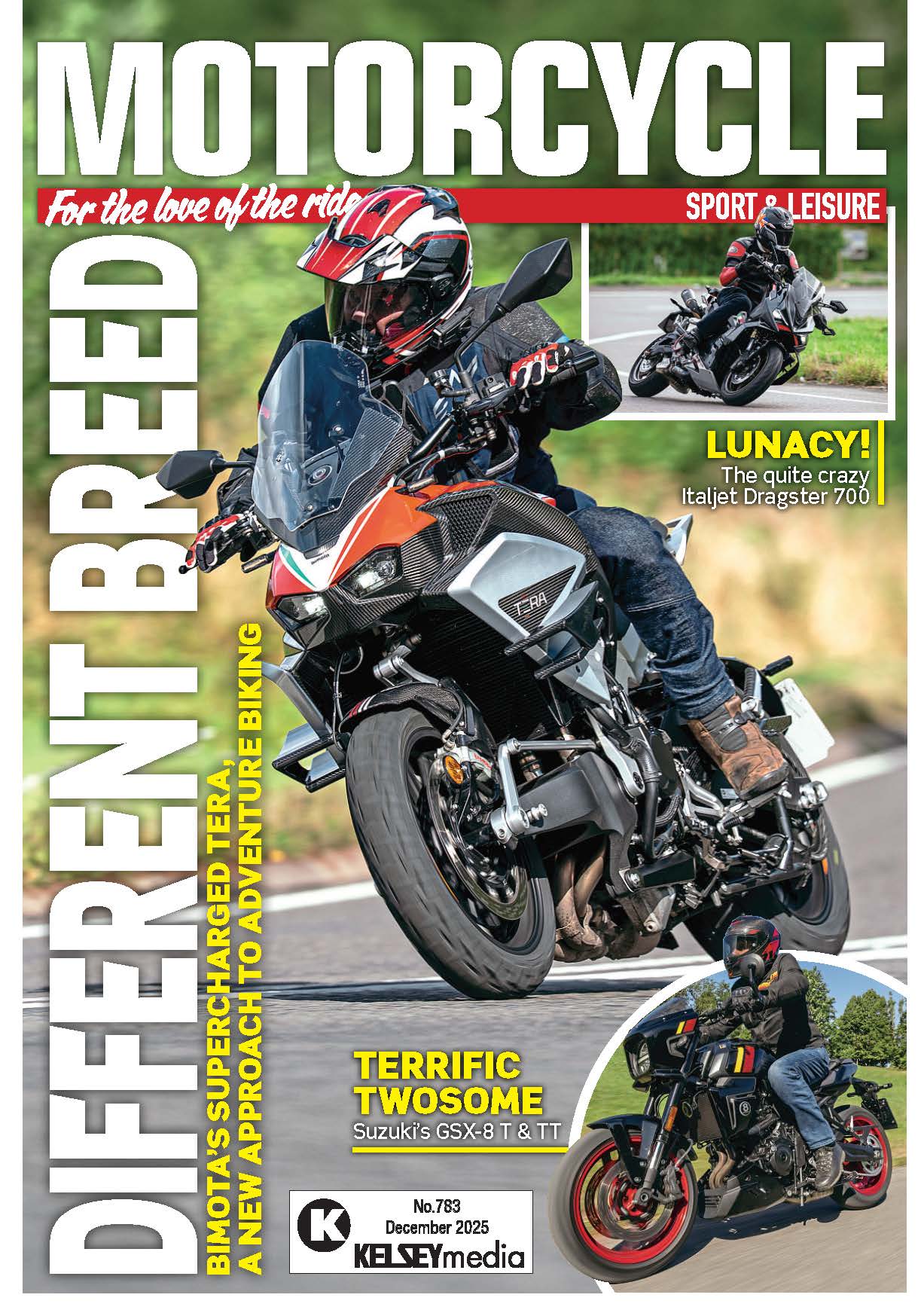In a bid to ensure it stays firmly at the top of the sportsbike pecking order, Ducati’s gone all out to create nothing short of a modern masterpiece. Editor Bruce Wilson tells us what we need to know…
There are some new bikes that come along and grab your attention for less time than it takes to tie a shoelace… And then there are bikes like Ducati’s new Panigale V4. A machine that’s simply exceptional and littered in so many performance-inducing intricacies that even the likes of Einstein would need a lie down after getting through half of them. As for me, my brain was fried after reading the first of many pages surrounding this new model’s raft of features and heavily revised focus. To put it simply, there’s never been a Ducati quite like this before so, before you go down the route of thinking it’s just a tarted-up take on the model that came before it, think again. No less than 94 per cent of the Panigale is new, while it could be said that 100 per cent of the thinking behind it is fresher than a mountain glade covered with Febreze.
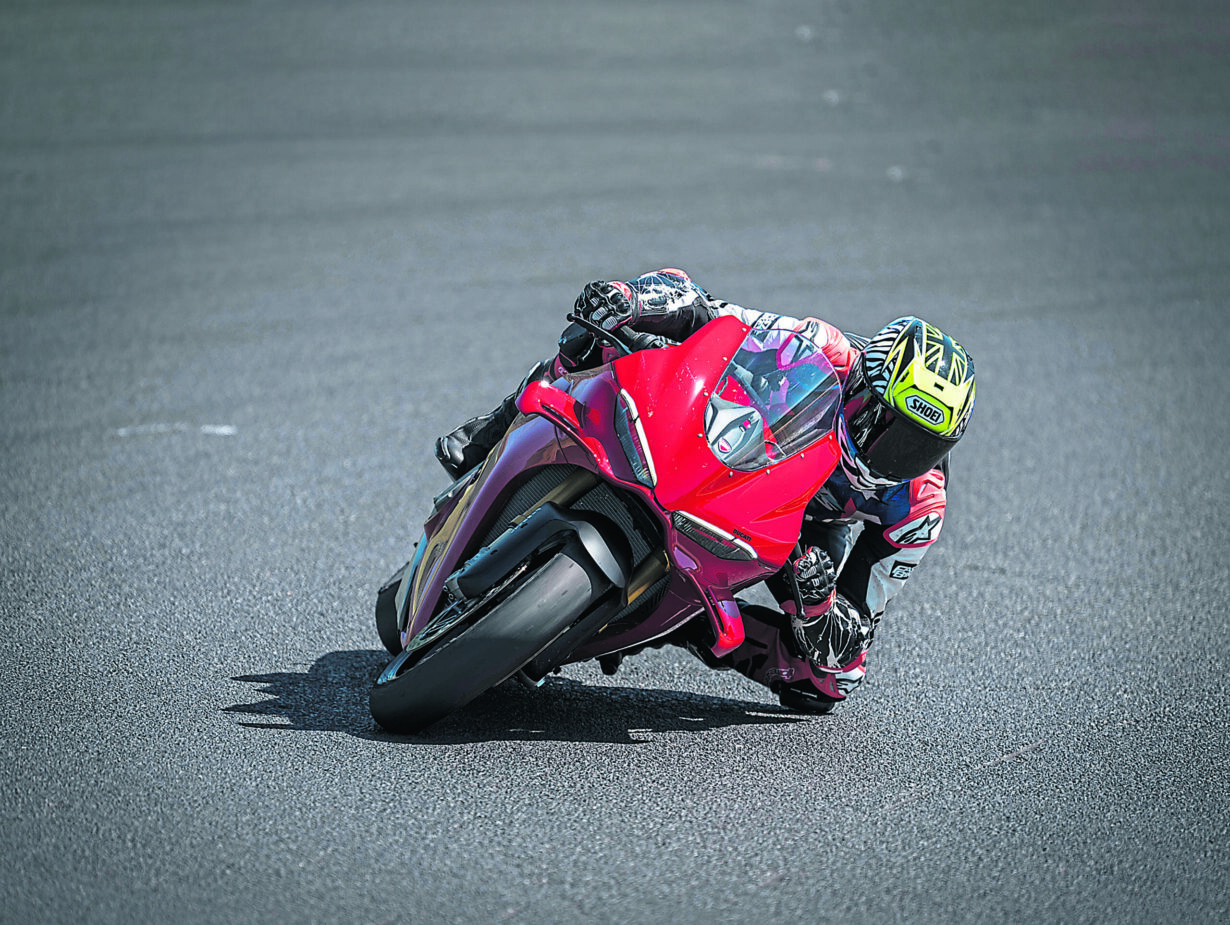
Building on the success of the three previous versions of Panigale V4, Ducati’s seventh generation sportsbike has blown the doors off of convention, delivering to the market a masterclass in innovation, while hammering home the point that Ducati will stop at nothing in its bid to build the very best of the best. If there’s one thing we all know about Ducati, it is its insatiable thirst for winning; a thirst so profound it could make a seasoned alcoholic appear like they’re having their first pint. Winning is very much in Ducati’s DNA and that’s a point the Italian marque hammers home with conviction on the racetrack. Be it at MotoGP or World Superbikes, it’s at the top… or at least for now. But if history has taught us anything, it’s never to be forgotten that complacency comes at a hefty, and often heartbreaking, price. Take your hand off the throttle for a moment and a rival will willingly escort you off of the podium.
Enjoy everything MSL by reading the monthly magazine, Subscribe here.
So how does Ducati ensure it remains at the very forefront, while taking on manufacturers with far more budget and resource at world championship level? Well, it has to work harder, smarter, faster. If you’re a fan of racing you’ll have seen innovation after innovation appearing on Ducati’s race machines, often starting out at MotoGP level, where the gloves are largely off in terms of development, before trickling its way down to production bikes, in order to fuel the homologated machines we see on the World Superbike grid, such as the Panigale V4R that took back-to-back wins in the hands of Bautista in 2022 and 2023. Okay, it might have slipped from its perch in 2024, but that only hammers home the need for the major overhaul of the brand’s flagship road-going sportsbike. It only seems like yesterday I was on the launch of the original version of the Panigale V4 at Valencia, back in 2018, being blown away by its brute force, smart tech and unmistakably GP-inspired soundtrack.
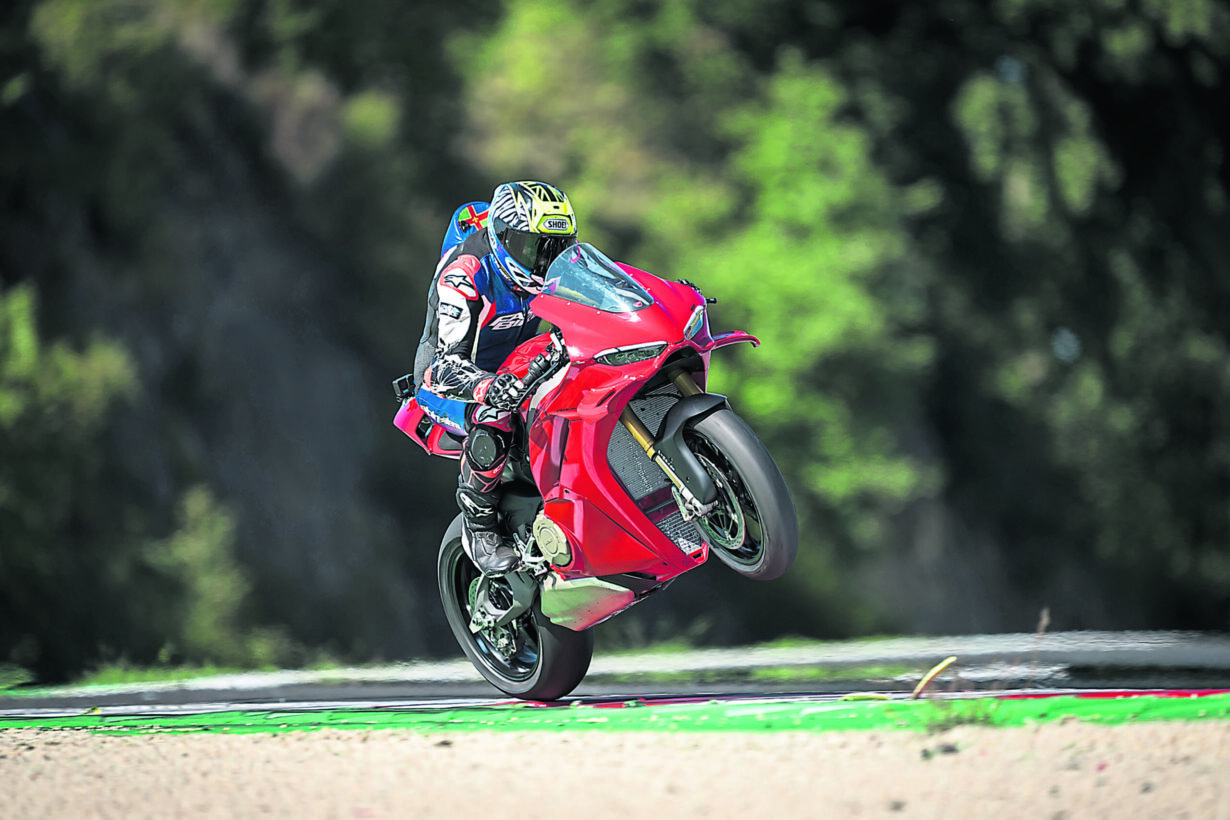
It was a pivotal point for the brand that then decided to turn its back on a long and successful v-twin lineage in pursuit of that next step. Fast-forward to 2020 and refinements came the V4’s way, followed by more tweaks in 2022. But if there’s a message in the launch of this latest iteration of the model, it’s that tweaks alone aren’t enough to stay ahead of the game. To be the best, you have to build the best and that’s the reason for the top-to-bottom rework of this protagonist. To call it revolutionary would encourage chuntering from armchair warriors, but rest assured that pretty much all of the bike is new… not just the addition of an unexpected double-sided swingarm or 916-inspired nose job.
So, before I get stuck into the riding experience, I’ll tick off the major focuses that were hammered home during the model’s presentation at a swelteringly hot Vallelunga racetrack, just outside of Rome. From a pure numbers point of view, the gains simply don’t do the model justice with the headlines being that this latest iteration weighs one kilo less than the last offering, while making 0.5bhp more. Of course, more power and less weight is what it’s all about, but if you were expecting to see some massive hike in power, or slash in weight, now’s the time to send an angrily headed letter to the fun police that govern Euro5+ emissions.

The fact that Ducati’s actually seen any kind of increase over the last Panigale is irrefutably impressive and it’s had to work hard to achieve it. How so? Well, the addition of new, higher duration lift cams have helped things along, while longer travel velocity stacks (going farther in each direction) has helped to achieve a better level of induction throughout the rev range. These enhancements aside, the V4 motor also benefits from the same gearbox as the one found in the Superleggera V4, while the alternator rotor and oil pump have been donated by the race-inclined V4R. The combination of which means more power with less heat, made all the sweeter by a big radiator to ensure optimised thermodynamics.
In the presentation room, neatly arranged along its walls were a variety of core components, with the ‘front frame’ being amongst the most enticing of all. For such a big, powerful bike, it beggars belief that the unit holding the motor to the forks is quite so minute, weighing in at just 3.5kg (a reduction of 700 grams). While a loss of weight was one goal of the new unit, the 40 per cent drop in lateral flex was perhaps the bigger of the aims. As good as the old frame was, complaints of its stiffness didn’t fall on deaf ears, and the same can be said about the swingarm. It seems strange to see a Ducati sportsbike with a double-sided unit, but that’s the place the brand now finds itself at, having been urged by Ducati Corse to go down this route.
Less weight, more flex, a massive hike in mechanical grip and consistent tyre wear formed the basis for this trajectory into new territory. Taking slimming to another level was the addition of forged, five-spoke alloy wheels that saved further kilos from the mix. The bad news is that if you want to become the proud owner of a set, you’d have to invest in the pricier V4S version of the Panigale, which hits home at £29,995, but for that sum you’ll also gain ownership of Ohlins’ third-generation electronic suspension.

While I’m on the topic of tech, a major emphasis of the new bike is the Ducati Vehicle Observer suite. That’s the name that’s been given to the next level of digital governance that incorporates 70 different sensor inputs, plus those detected by the IMU, to refine and master the model’s raft of rider aids. Access to these is granted via a new, super-sexy seven-inch, full-colour dash. There’s not enough time in the day to go through its plethora of features and options, but needless to say it’s littered with multiple levels of traction control, wheelie control, engine brake management and engine outputs.
There are also five different rider modes on tap, that are each customisable. One thing I hadn’t expected was the seven levels of ABS. The higher the number, the more engaging the system, but it was the lower two settings that really captured my attention. In level 2, you get a track-focused, front-only ABS set up that even a pro could go racing on. But for those that want to explore something wholly different to the Panigale’s pedigree, level one sees combined braking performance, with the rear brake being moderated to complement the stopping force of the box-fresh Brembo Hypures that adorn this ballistic beauty.
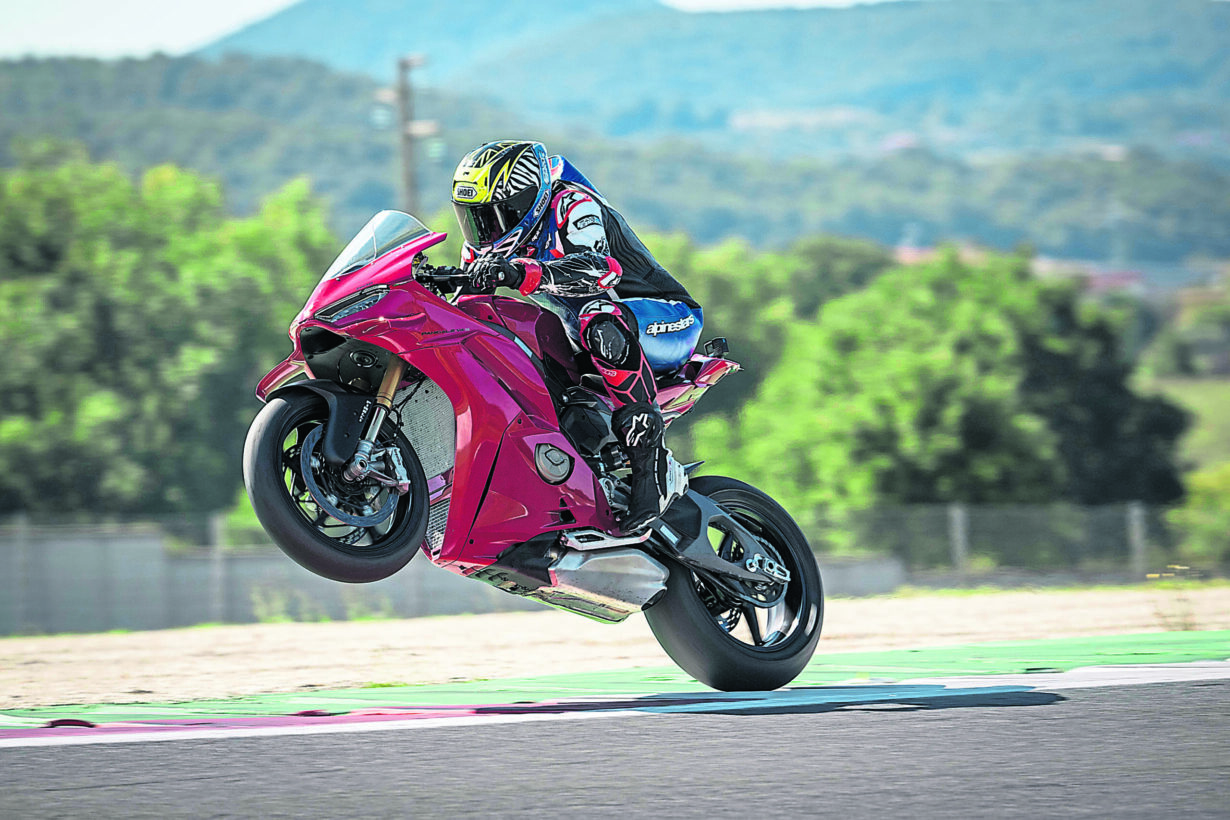
From an aesthetic point of view there’s no mistaking this to be anything other than a Panigale V4, but the changes to the bike’s bodywork ensures it’s not only four per cent more aerodynamically efficient than its predecessor, but also unmistakably different. As already mentioned, Ducati claims the 916 influenced the look and lines of the bike, which maybe rings true after a bit of squinting, with a suggestion that even the new design of wings followed the lines of the iconic machine’s bodywork. Whatever the influence, the bike seems smaller, more compacted, and encapsulating of the rider thanks to a new narrower, taller 17-litre tank and a reworked tail unit, too.
The ergonomic triangle is pretty similar to before, but the same can’t be said of the seat that is now flatter, longer and wider. And to complete the racier, yet comfier, directive, the pegs have been made narrower (for more ground clearance), the screen has been made taller (to make life easier on the rider), and the bottom of the tank features textured areas so you can get better grip when hanging off farther than Bagnaia.
With a brain full of facts, figures and countless more questions based on what we’d just heard, the time had finally come to put this bike to test, and to ensure those of us riding got the best experience from the package, we were each given our own Ducati engineer… which only added to the experience. Whether or not it was a consideration from the Italian brand to ensure we actually rode the bike in the direction of its potential is a discussion for another day, but what it meant to me was there was a bloke on hand to help me explore the potential of this 213bhp reprobate, that felt anything other than overwhelming when I tootled around the circuit to get some idea of its layout. Vallelunga is a beautiful track, blending absolute all-out madness in the first half of the circuit with a tight and technical latter half that demanded you used first gear whether you liked it or not.
As the day went on, it would grow on me massively, but the initial 15-minute session was nothing short of mind-boggling and I was thankful that the Panigale was so forgiving as I stabbed at the throttle and brakes with the finesse of a four-year-old. The engine was so much smoother than I’d imagined, being plentifully potent when asked to perform, yet docile enough to stay composed and restrained at lesser speeds in a way the old Panigale V4 motor simply wouldn’t. And to make things even better, I quickly came to realise how slick and effortless the shifter and blipper were.
As mentioned, a good few corners on the track demanded first gear, which is a selection I rarely make because it necessitates going past neutral. But my concerns were pointless as the downshift was slicker than a greased dolphin. The new bike sports a development called Ducati Quick Shift 2.0, which basically means it’s got rid of the need for a microswitch, so gear changes feel more direct and natural. Honestly, in my opinion, there are few, if any, systems on production bikes that can go toe-to-toe with this piece of tech – it was awesome. The other thing that jumped out during that initial ride was how easy it was to place the Ducati, even on the tighter, slower bends on track, such as a corner called Tornantino, which was all about big lean and a sundial-paced apex.
In the blink of an eye, that first session was in the bag, with my best time being a humbling 1m 53sec lap – around 13 seconds off the front row pace of litre bikes in the Italian superbike championship. I’d like to think I was just taking my time to get to know the V4, which felt wholly different during my second outing. As warm and welcoming as the Ducati was first time out, I was hoping for fireworks as I left pitlane for that second thrashing. The only change to the bike was a switch from ABS level 2 (front only, race attack-inclined) to ABS level1 (The same from the front but with the added benefit of a linked rear brake), with the same ‘High’ power engine delivery as had been selected before.
Arguably, I could have been in for a copy and paste performance from the V4, but what I got blew my mind. I pushed a bit harder, braked a bit later, and tried to capitalise on the more familiar layout of the circuit, which only seemed to get madder and more addictive with pace. Likewise, that’s how I’d describe the Ducati. Having only tickled it on my first onslaught, I never really got the bike working hard enough to show off its character… but that all changed. I could feel the front squirming on the anchors, the rear beginning to move on the gas, and the weave of the bike, pinned in fifth, tackling the kinky start straight really got my heart rate racing. Admittedly, it’s a fine line between wanting a bit of character and being conspicuously battered by a bike for taking the mick, but what the Ducati was now delivering was that perfect middle ground: all the excitement without any of the pain.
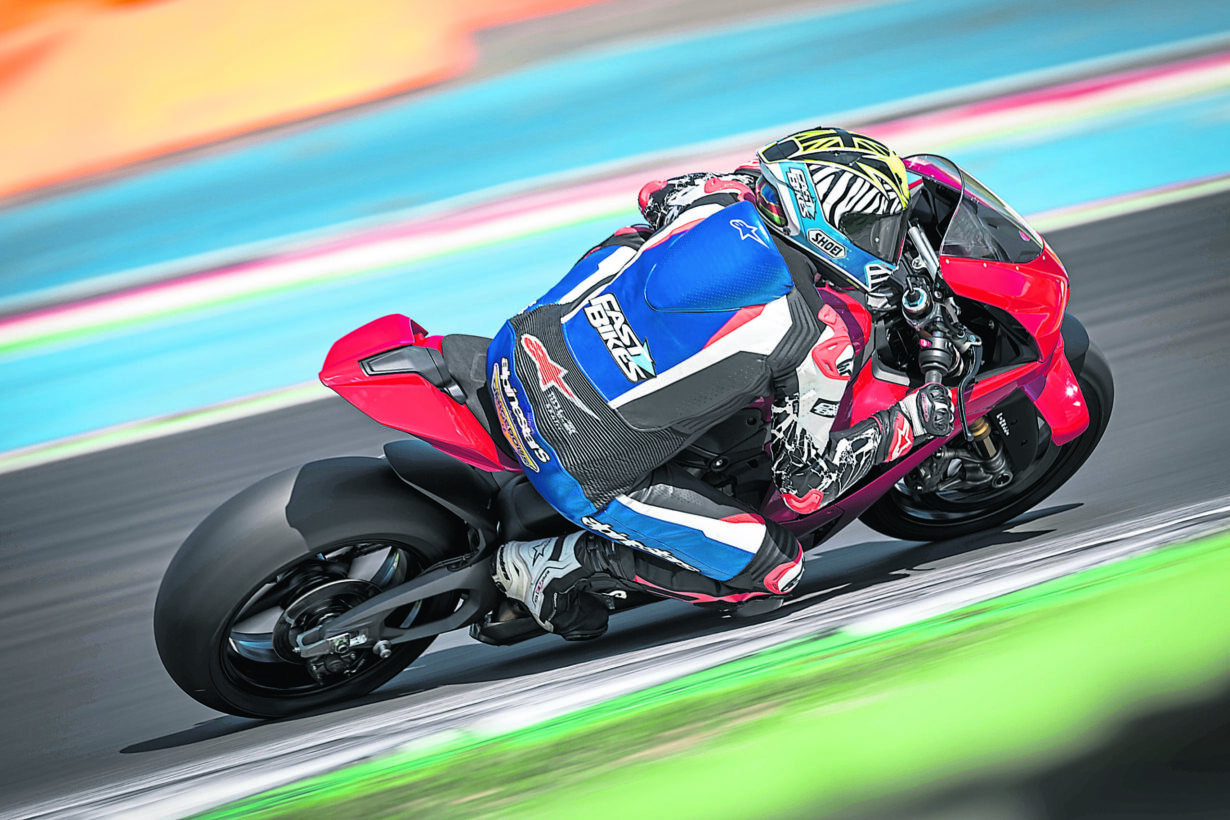
I was loving it and felt egged on by the added level of feel and movement that was translating through the tyres to the suspension and the telling frame. Arguably, the bike needed a bit more support from the Ohlins, but the Pirelli slicks were doing a cracking job of keeping the Panigale pinned to the track, and the tech was, too. Only now was I getting the traction control kicking in, and only then on one or two of the corners. The thing is, I’d see the fancy dash light up as the TC got leaned on, but I’d be lying if I said I could feel its interaction. The set up was seamless and so, too, was the wheelie control. Out of the slower bends, despite a mapping of power in the lower gears to limit torque for safety’s sake, wheelies were as inevitable as governments raising taxes; they were nothing short of guaranteed, with the only variable being how high or how long they’d last before they got brought into check. Again, all this happened without any angry intervention to the drive, allowing me to keep the throttle firmly pinned as the tech did its thing.
As the sessions clicked by and the mocking from my mate on the data ramped up, the Panigale and I really started to gel. By the early afternoon I was feeling super-comfy on the bike, having made little-to-no changes to its extensive web of electronic warfare. Yeah, I’d firmed the bike a little but everything else was pretty much as it came. This being the case, my pace was ramping up nicely with consistent 1min 46s being the order of the day by the second half of our innings. I knew where there was more time to be found and that came down to trusting the bike to do what it was capable of. What had also hit home by this point in the day was how consistent the experience was, quite unlike the Panigales of old. I knew that if I braked at a certain point, I’d be guaranteed to make that corner entry, or that by braving it out of a bend at full throttle, the tyres and chassis would happily take the abuse.
More to the point, the traction control, as dialled down as it was, was unequivocally dependable, whatever the speed. It became a game of point and shoot, pre-anticipating the reaction of the bike and building trust in it when that exact thing happened again. Even when more tenths were taken from the time, the Ducati’s behaviour was up there with a loyal Labrador… It’s hard to describe how much the thing grew on me, and the same has to be said of all its tech. The system on the bike that probably won me over the most was the traction control, but the rider aid I hadn’t expected to be so surprised by was the linked brakes.
In the latter part of the day, I went back to ABS level 2 (front brake only) and not only did the bike feel harder to slow, it also became harder to turn and hold a line. I couldn’t wait to change it back and regain that rear brake support that I didn’t know I wanted or needed. I’m telling you, that system is genious and a gamechanger to riding fast. Apparently, factory Ducati GP rider and two times world champion, Peco, had said a similar thing when asked for his thoughts on it at the end of his testing of the bike, which says it all when a rider of his level has such thoughts.
The more I rode that bike, the more I liked it, not just from a mechanical point of view, but also from the point of ergonomics. I liked how spacious it was, with plenty of room to hustle around the seat. For me at 5’ 10”, the pegs offered more than ample leg room and the flatter seat meant my wrists weren’t quite so laboured on the wide bars. The big screen felt easy to tuck in behind and the large dash was so easy on the eye. During the test I became pretty obsessed by my lap time and my eyes were drawn at key moments to the live splits that flashed up if I was up or down on my best sector time. Likewise, the buzz of seeing your new best lap pop up on the display was something else and made me appreciate just how advanced and focused this model is. Sure, it’s got indicators, headlights and a horn, but the truth is that beneath all that road-going clutter lies a ballistic beauty born and bred with performance at heart… even the sound of it made me feel like I was on a pukka race bike. I genuinely fell for everything that this bike was about, but also wound up the test realising that despite six, 15-minute sessions in the bag and having knocked over 10 seconds off my inaugural lap time, I’d only just touched the surface with this thing. What a piece of kit.
Tech Spec:
Engine
Type: 90° V4, liquid cooled
Bore x Stroke: 81mm x 53.5mm
Compression: 14.0:1
Fuelling: EFI
Claimed Power: 213bhp @ 13,500rpm
Claimed Torque: 120.9Nm @ 11,250rpm
Electronics
Riding Modes: Yes
Traction Control: Yes
ABS: Yes
Quickshifter/Autoblipper: Yes
Wheelie Control: Yes
Launch Control: Yes
Pit Limiter: No
Cruise Control: No
Chassis
Frame: Aluminum ‘Front Frame’
F Suspension: Ohlins 43mm NPX25/30 forks, TiN treatment, Ohlins Smart EC 3.0
R Suspension: Öhlins TTX36 unit, Ohlins Smart EC 3.0
Front Brake: Twin 330mm floating discs, Brembo Hypure monobloc calipers
Rear Brake: Single 245mm disc, Brembo twin piston caliper
Dimensions
Wheelbase: 1485mm
Seat Height: 850mm
Wet Weight: 187kg (minus fuel)
Fuel Capacity: 17 litres
Info
Price: £29,995
From: www.ducati.com


